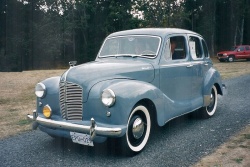 1950 Austin A40. Click image to enlarge |
Article and photo by Bill Vance
The first post-war Austins and other small British cars that arrived in North America following the Second World War were slightly re-worked pre-war designs. This would soon change, however, and the Austin Motor Company of Longbridge, Birmingham, was one of the earliest to offer an all-new model, the Austin A40.
The Austin name was not entirely unknown here because the American Austin Car Company of Butler Pennsylvania, later the American Bantam Car Company, had produced an Americanized version of the tiny English Austin Seven in the 1930s. They were perceived as too small for our conditions and didn’t enjoy much sales success. American Bantam ceased building them in 1940.
The 1948 Austin A40 was a whole new approach. It came as the two-door Dorset and four-door Devon and was a modern, conventionally engineered design, apart from its hydromechanical brakes (hydraulic front, mechanical rear). Suspension was independent in front with coil springs and A-arms, while at the rear were leaf springs and a solid axle. It had arm-type front shock absorbers which tended to weaken, causing the car to “porpoise” over undulating roads.
Power came from an inline, overhead valve, 1.2-litre four-cylinder engine developing a modest 40 horsepower and driving the rear wheels through a floor-shift, four speed manual transmission.
By North American standards the A40 was quite small. It had a wheelbase of only 2, 349 mm (92.5 in.), overall length of just 3,886 mm (153 in.) and weighed 975 kg (2,150 lb). As a comparison, a 1948 Chevrolet had a 2, 946 mm (116 in.) wheelbase, was 5,029 mm (198 in.) long and weighed some 1,452 kg (3,200 lb).
The A40’s body styling was pleasant, if a little stubby by American car standards. It still had a somewhat dated upright horizontal bar grille, the top half of which rose with the hood. The front fender line swept down and back to conceal running boards and the overall width of 1,549 mm (61 in.) meant the A40 was strictly a four passenger car.
Those passengers were luxuriously accommodated in a nicely finished interior and comfortable leather seats; and if the trunk wouldn’t hold all of their luggage, the lid was hinged at the bottom and when swung down and supported by its sturdy straps, it provided an extra cargo platform.
Performance was modest. Road & Track (8/’51) recorded a leisurely zero to 96 km/h (60 mph) time of 29.4 seconds, although top speed was a surprisingly good 117 km/h (73 mph). The A40 was frugal on fuel, being capable of 35 to 40 mpg.
Like other small English cars of that era the A40 was geared quite low with the result that the little engine had to spin over at high r.p.m. to maintain the usual North American 96 km/h (60 mph) cruising speed. The Austin was much more comfortable at 80 (50), which required 3,350 r.p.m. To demonstrate its stamina, Austin Motor Company had an A40 driven 10,000 miles in as many minutes on a race circuit in Montlhery, France.
The A40 arrived at a propitious time because the marketplace was still suffering a shortage of new cars caused by the auto industry’s three-and-a-half-year shut-down during the Second World War. The result was North American sales of over 20,000 A40s in 1948.
This was so encouraging that late in the year the Austin Motor Company announced it would begin assembling cars in Canada. They established the Austin Motor Company (Canada), obtained a plant in Hamilton, Ontario, and began preparing for the production of A40 and sporty A90 models beginning in 1949.
The plan was to produce cars for the North American market, but it was not to be. With the satisfaction of the pent-up demand for cars, Austin sales fell to 17,700 in 1949, in spite of the addition of the Countryman station wagon and the end of the two-door Dorset.
A drastic devaluation of the pound sterling in 1950 made English cars more competitive and A40 sales temporarily jumped to almost 30,000 cars and wagons. This was short lived, however, and in 1951 even the addition of the smart little A40 sportster couldn’t keep North American sales from falling to 6,200. All Canadian production plans were abandoned.
The original 1948-1951 A40 was replaced by the more bulbous Somerset for 1952. Also in 1952, the 1953 Volkswagen Beetle began arriving in Canada (VW had been in the United States since 1949), and VW gradually started taking over the small car market.
While the Austin A40 wasn’t an outstanding car in any particular aspect, its engine did turn out to have a heart of gold. It was sturdy, readily expandable and provided the basis for the British Motor Corporation’s B-Series four that would power a variety of cars from the Nash/Hudson/AMC Metropolitans to MGBs.








